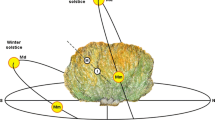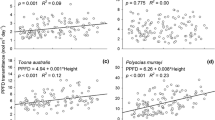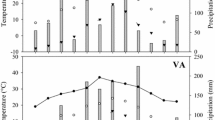Summary
The crown light environments of saplings of two Costa Rican rain forest tree species were simultaneously compared. The species, Dipteryx panamensis (Pitt.) Record & Mell., a relatively shade-intolerant species, and Lecythis ampla Miers, a shade-tolerant species, have contrasting growth and branching patterns. Quantum sensors were placed throughout the crowns of saplings up to 2.5 m tall and quantum fluxes were recorded with microloggers for seven-day periods. The shade-intolerant species had total quantum flux densities 35% larger than those of the shade-tolerant species, but totals for both species were less than 2% of full sun. More than 90% of the quantum flux densities measured within the crowns of both species were less than 25 μmol m-2s-1. Lateral light was an important component of daily quantum flux totals; for saplings of both species, the half-hour with the maximum average irradiance for the day frequently occurred in mid-morning or midafternoon. Despite dissimilar crown and leaf display, there was no difference in the overall variability of irradiance within the crowns of the two species. However, quantum fluxes received within the crowns differed substantially in both species. Within-crown locations differed significantly from day to day because of variation in weather conditions. Daily total quantum flux densities and totals expressed as a percent of full sun were significantly correlated with height growth over the previous 12 months.
Similar content being viewed by others
References
Bazzaz, FA (1984) Dynamics of wet tropical forests and their species strategies. In: Medina E, Mooney HA, Vazquez-Yanes C (eds) Physiological Ecology of Plants of the Wet Tropics. Dr. W. Junk Publishers, The Hague, pp 233–243
Björkman O, Ludlow MM (1972) Characterization of the light climate on the floor of a Queensland rainforest. Carnegie Inst Washington Year Book 71:85–94
Brokaw NVL (1985) Treefalls, regrowth, and community structure in tropical forests. In: Pickett STA, White PS (eds) Natural Disturbance: The Patch Dynamics Perspective. Academic Press, New York, pp 53–69
Chazdon RL (1986) Light variation and carbon gain in rain forest understory palms. J Ecol 74:995–1012
Chazdon RL, Fetcher N (1984) Photosynthetic light environments in a lowland tropical rain forest in Costa Rica. J Ecol 72:553–564
Chazdon RL, Field CB (1987) Photographic estimation of photosynthetically active radiation: evaluation of a computerized technique. Oecologia (Berlin) 73:525–532
Clark DA, Clark DA (1987a) Analisis de la regeneracíon de árboles del dosel en bosque muy húmedo tropical: aspectos teóricos y practicos. Rev Biol Trop 35 [Supp]:41–54
Clark DB, Clark DA (1987b) Population ecology and microhabitat distribution of Dipteryx panamensis, a neotropical rain forest emergent tree. Biotropica 19:236–244
Denslow JS (1980) Gap partitioning among tropical forest trees. Biotropica 12 [Suppl]:47–55
Evans GC, Whitmore TC, Wong YK (1960) The distribution of light reaching the ground vegetation in a tropical rain forest. J Ecol 48:193–204
Fetcher N, Oberbauer SF, Rojas G, Strain BR (1987) Efectos del régimen de luz sobre la fotosíntesis y el crecimiento en plántulas de árboles de un bosque lluvioso tropical de Costa Rica. Rev Biol Trop 35 [Suppl]:97–110
Gutschick VP, Barron MH, Waechter DA, Wolf MA (1985) Portable monitor for solar radiation that accumulates irradiance histograms for 32 leaf-mounted sensors. Agric Meteorol 33:281–290
Hartshorn GS (1978) Tree falls and tropical forest dynamics. In: Tomlinson PB, Zimmermann MH (eds) Tropical Trees as Living Systems, Cambridge University Press, New York, pp 617–638
Hartshorn GS (1980) Neotropical forest dynamics. Biotropica 12 [Suppl]:23–30
Hartshorn GS (1983) Plants. In: Janzen DH (ed) Costa Rican Natural History. University of Chicago Press, Chicago Illinois, pp 118–157
Pearcy RW (1983) The light environment and growth of C3 and C4 tree species in the understory of a Hawaiian forest. Oecologia (Berlin) 58:19–25
Whitmore TC (1975) Tropical rain forests of the Far East. Clarendon Press, Oxford
Whitmore TC (1978) Gaps in the forest canopy. In: Tomlinson PB, Zimmermann MH (eds) Tropical Trees as Living Systems, Cambridge University Press, New York, pp 639–655
Woodward FI, Yaquib M (1979) Integrator and sensors for measuring photosynthetically active radiation and temperature in the field. J Appl Ecol 16:545–552
Yoda K (1974) Three-dimensional distribution of light intensity in a tropical rain forest of West Malaysia. Japan J Ecol 24:247–254
Author information
Authors and Affiliations
Rights and permissions
About this article
Cite this article
Oberbauer, S.F., Clark, D.B. & Quesada, M. Crown light environments of saplings of two species of rain forest emergent trees. Oecologia 75, 207–212 (1988). https://doi.org/10.1007/BF00378599
Received:
Issue Date:
DOI: https://doi.org/10.1007/BF00378599




